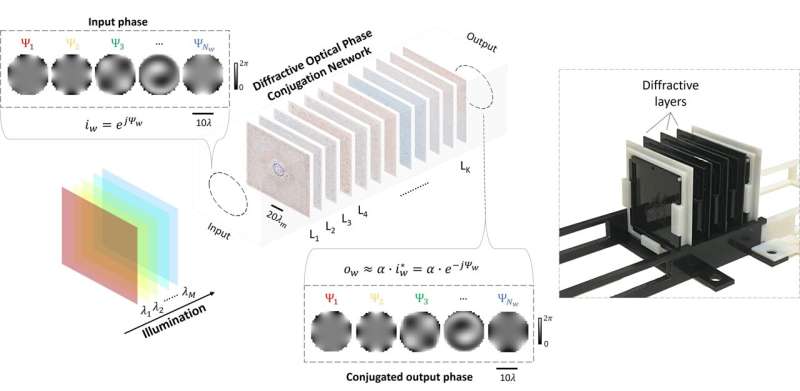This article has been reviewed according to Science X's editorial process and policies. Editors have highlighted the following attributes while ensuring the content's credibility:
fact-checked
peer-reviewed publication
trusted source
proofread
Scientists unveil all-optical phase conjugation method using diffractive wavefront processing

Scientists at the University of California, Los Angeles (UCLA) have unveiled a technology that could revolutionize the fields of imaging and optical communications. Led by Aydogan Ozcan and his team, the research introduces an all-optical phase conjugation (OPC) method using diffractive wavefront processing.
This new technique offers unprecedented capabilities in correcting optical distortions at multiple wavelengths and could have significant implications across various fields. The work has been published in Nature Communications.
Traditional methods of optical phase conjugation, which include analog and digital techniques, have long been used to correct wavefront distortions in applications ranging from medical imaging to laser beam focusing. However, these methods often come with limitations such as low energy efficiency, narrow-band spectral operation, high system complexity, and slow response times.
The new all-optical phase conjugation approach developed by UCLA researchers overcomes these challenges by using deep learning to optimize a set of passive diffractive layers that can process distorted optical fields and all-optically generate their phase-conjugated counterparts at multiple wavelengths.
This method is not only faster and more energy-efficient but also more compact and scalable than existing technologies, covering applications spanning different spectral bands.
The innovative OPC framework is built on deep learning-engineered diffractive optical structures. These structures are designed to perform phase conjugation on optical fields with unknown phase distortions.
By passing light through a series of 3D-printed diffractive layers, the system can transform distorted wavefronts at multiple wavelengths into conjugated ones at the speed of light, without the need for digital computation or active modulation.
The UCLA team demonstrated the efficacy of their system using terahertz (THz) radiation. They fabricated a three-layer diffractive OPC processor and successfully corrected optical distortions that had never been encountered during the training of the model. This experimental validation confirms the system's capability to handle real-world optical distortions effectively.
This breakthrough in optical phase conjugation has far-reaching implications for various fields:
- Medical Imaging: The technology can improve the quality of images obtained through turbid media, such as biological tissues, which could lead to better diagnostics and treatments.
- Optical Communications: By enhancing the clarity of signals transmitted through atmospheric or underwater channels, this technology can improve the efficiency and reliability of optical communication systems.
- Laser Systems: The ability to correct laser beam distortions in real-time can lead to advancements in precision manufacturing, materials processing, and scientific research.
- Astronomy: The technology can assist in correcting atmospheric distortions in telescopic observations, enabling clearer and more detailed images of celestial objects.
The versatility and robustness of this all-optical OPC technology make it a promising candidate for a wide range of applications. The research team is now exploring ways to extend the technology to operate across different spectral bands, including visible and infrared light. This would open up new possibilities in areas such as environmental monitoring, security, and beyond.
"Our all-optical phase conjugation framework offers a novel and effective solution to a problem that has challenged scientists for decades," said Aydogan Ozcan, senior author and professor of electrical and computer engineering at UCLA.
"We are excited about the potential applications of this technology and are committed to advancing its development for practical uses."
More information: Che-Yung Shen et al, All-optical phase conjugation using diffractive wavefront processing, Nature Communications (2024). DOI: 10.1038/s41467-024-49304-y
Journal information: Nature Communications





















